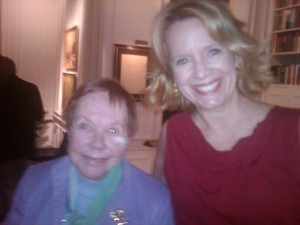by Mary Lou Quinlan
Published February 9, 2011 in Tech
This title probably gives me away. I’m becoming a digital doubter. While I’m a believer in the power of technology to connect consumers and to enable them to share their customer experiences, I want to challenge the deterioration of the value of online word of mouth among women.
I am worried that our online marketing strategies are killing WOM, the gold standard of trusted endorsement by making it too easy, too anonymous, too paid. I’m concerned that buyers will become either unwitting sandwich boards or simply shills for brands. And I’m wondering if consumers, especially the all powerful female consumers, might begin to shut out the din of too many recommendations without merit or trusted sources.
If women are paid or spiffed for every referral they give, whether it’s a laundry detergent or a dentist, at what point do their friends start to feel they’ve sold out? At what point, does that brand start to look like it’s just buying customers, not creating believers? Is social media ruining what was once a good thing?
I’ll focus on women, not only because at Just Ask a Woman, we’ve studied them for 12 years but because women are the more active online bloggers, gamers, voters and emailers, not to mention, the more powerful gender as measured by their online (and in-person) purchasing dollars. Fifty two percent of women have a facebook or a myspace account and 18% of them update their pages at least once a day, according to 2009 studies. In recent research we conducted, 56% of first time moms share intimate information about their pregnancy with other moms to be online. But intense usage isn’t restricted to women in their 20s or 30s. Women 55 and above comprise the fastest growing demographic on facebook. Their membership is up over 175% in 2008, significantly higher than men of that age group.
Women’s propensity to recommend products isn’t new. Women have always passed the word about products they liked. For decades, a coupon or a freebie was enough at least to attract their attention, if not their loyalty. But things are different now. Marketers are in even hotter pursuit of women’s endorsements so they use social media and mobile technology as the new enablers of a national conversation about brands, good and bad. And that conversation is becoming as mindless and quick as a click.
Women’s warp speed WOM online
At Just Ask a Woman, we’ve tracked women’s power as brand ambassadors and brand killers. Women love to tell other women about good product experiences and just as willingly (even more so!) will dish about bad ones. Back when we started our business, research showed that women will tell 4 to 7 people about a good experience and 7 to 13 about a bad one. Worse, if they have a really awful product or service incident, they will retell the story in all its gory detail for an average of 23 years.
Of course, all this telling used to be face to face over the proverbial picket fence. Now we’re drowning in the online bottomless pit of instant passalong kudos and criticisms. Have a complaint about a hotel? Why go to the trouble of writing a handwritten letter to the company CEO when you can post your rant about your unmade bed on tripadvisor.com in seconds? Someone treat you badly at GAP? Don’t wait to talk to the department manager, just tweet out your frustrations and get shoppers all around the mall ticked off.
If you like something, anything, just click “like it!’ and you join hundreds of like-minded souls on facebook. You’ve probably done it yourself. How many of us have retweeted something that we didn’t even fully read or view? We click “recommend” as casually as we hit delete. But like hitting “reply all”, unconsciously passing along viral brand material risks ticking off more people than we please.
Believing Whole Truths or Half Truths?
Technology has made it possible to recommend a product to millions of people even when we’re unaware we’re doing it. With automated ‘recommendations’ brands can use social media to do the actual work of getting the word out so we don’t have to. For example, go to your favorite frozen yogurt shop and buy a cone. If you’ve registered for a frequent customer card in the past, swipe it at the register and the yogurt company will let foursquare members know that you enjoyed your visit to the store at 3rd and Main. Vaseline Intensive Care set up a Dry Skin Relief Patrol that will send you a free sample if you share the name of another friend with dry skin who ought to know about the brand.
Pretty much every launch in recent months includes some kind of social media platform to ‘use’ consumers to spread the word in exchange for contest entry or freebie. Not an earth-shaking bit of marketing news, but this can lead to what we call Half Truth marketing sabotage. Think of it this way: Her Half Truth is “I really liked this brand.” Her Whole Truth: “I don’t even remember that I signed up to post this stuff and now the product isn’t working for me anymore.” (Unfortunately, her friends don’t know the difference.)
Interestingly, most women tell us that they do trust what other women say online, especially if an opinion emerges multiple times. This coincides with a phenomenon that we unearthed years ago, women’s reliance on their custom made Board of Directors, the circle of advisors they’ve collected for their expertise on various topics. She counts on this ad hoc group for information and decision making. She might have a board for travel or finance or parenting issues. But now, her board is populated with lots of people she’s never even met.
Today’s Board may be a far flung group of strangers who share an interest or an advocacy or a talent ripe for access on her keyboard or iPad. If she relies on a neighborhood community site or the blog of a well-regarded author, at least she’s connecting to someone with an identity. But women also turn to the huge anonymous blogosphere and twitterverse for opinions and ideas. Without the benefit of a calling card, women still count on what those other women suggest, especially other mothers, because as they put it: why would a mother lie about something that has to do with a child? What would be her motivation to exaggerate or to pass along a suggestion she didn’t believe in? What, indeed?
Endorsements for Love…or Money?
In 2011, we are light years beyond the innocence of original word of mouth endorsements. Thanks to too much ‘pay for play’, it’s hard to know if a thumbs up came from someone genuinely impressed with a product or service, or someone with her fingers in the cash register. Some mom bloggers have particularly been taken to task for being too willing to accept merchandise, trips and other honors in exchange for a good review. Thanks to recent uproars on the subject, the leaders of the women’s blogging community have been pushing for a code of ethics and standards of behavior that align them as either journalists or serious reviewers or else, Moms for sale.
Even the gravy train of brand swag may be slowing down since marketers are able to get endorsements without giving away the store because there are plenty of consumers who just do it for the ego validation, the community, the sense of ‘being heard.’ What a boon for marketers to get the big payoff of customer endorsement without paying a single dime beyond creating the site or promotion!
As more and more customers pile on the social media “brand”wagon, prepare for dangerous curves ahead. If the ingoing premise was that social media would engender viral word of mouth, how long before these cyber “say so’s” are ignored? And another watch out for marketers: recently we’ve heard brand managers claim that they are measuring success of their campaigns by the number of “likes” on their brand’s facebook page. Who’s to say if those are genuine consumer fans (no wonder facebook eliminated that term!) or just employees and their friends driving up the numbers for other reasons?
A Prescription for Truth
Even with all these doubts, I don’t want to leave you with the sense that I am anti-social media or despairing that no good can come from all this. Companies are under the digital global microscope every day now. Recalls can’t hide in the dark. Consumer complaints cannot be filed behind some dusty counter, never to be fixed. Women’s voices can become the powerful police of a better marketing world. But not if marketers have bought them out.
What’s the remedy? Forewarned is fore-armed. Be sure that the consumers you enlist have really tried and enjoyed your product. Keep your processes transparent. Dare to re-ask your enlisted customers just how happy they continue to be and fix it when they aren’t. If you can send samples or coupons directly to their friends who request them, work to earn those relationships. And you need to deliver on a great brand experience when that new customer comes your way from a social media referral.
There is nothing more powerful than a heartfelt endorsement from a woman. But the overkill of the social media tactic could be a short term win with long term consequences. And, if no one believes your “real person online testimonials”, what will that say about you?
This article is also available at Canvas8.
Tags: Advertising, Internet, Social Networking
share the love:















